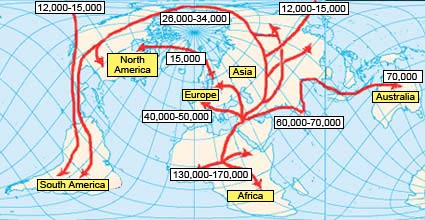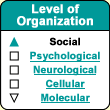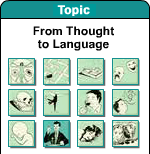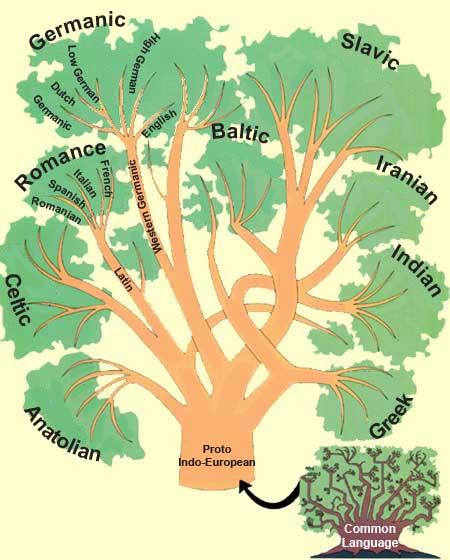|
|
|
|
 |
| Communicating in Words |
 |
|
|
|

 |
 |
 |

 |
 |

 |
There are two main ways
of classifying languages. Typological classifications
are based on the resemblances between the languages to be
classified, without regard to their origins. According to
this principle, three types of languages can be distinguished.
In inflected languages, such as French,
the words in a sentence change form according to their grammatical
relationship to one another. In agglutinative languages,
such as Japanese, words are formed by the addition of affixes
to a root. In analytic or isolating languages,
such as Chinese, the words tend to be invariable.
In contrast with typological classifications, which do not
address relationships among languages, genetic classifications
attempt to group languages into families all of whose members
derive from a common ancestor. These classifications are established
by historical linguists, who analyze the evolution of languages
through the methods of comparative grammar. These linguists
compare words in different languages for similarities in sound
(phonetics), meaning (semantics), form and grammar (morphology),
and vocabulary (lexicology), then use various criteria to group
the languages into families that have a common origin. This
is the approach used by linguists who believe in monogenism. |
About 6000
languages are spoken in the world today, of which about 1000
are spoken only by very small populations. It is estimated
that nearly half of these 6000 languages are threatened because
they are spoken only by adults who no longer teach them to
their children.
The death of languages is not a new phenomenon. Linguists estimate
that over the past 5000 years, at least 30 000 languages have
been born and died, generally without leaving a trace. But
today, the number of languages spoken in the world is declining
at an unprecedented rate, so that over the coming century,
90% of the languages that exist now will likely disappear.
There would then be only about 600 languages left that would
have proven relatively durable. One of these, of course, will
be English, which is spreading more and more widely and on
its way to becoming the common language of the world.
|
|
|
There are so
many theories about the mechanism by which human language may
have emerged that it's tempting to say that every researcher
who has looked at this question has a theory of his or her own.
But regardless of how language emerged, another question arises
immediately: did it do so once, or many times? In other words,
do all languages have a common origin, a proto-language that
gave rise to all the rest, or did several different dialects
emerge, at various places in the world?
This question opens another great debate
about the origins of language and of the various languages. Those
who argue for the multiple origins, or polygenism,
of language, say that the first modern humans did not share the
potential for the faculty of speech, and that only after they dispersed
through migration did actual languages develop independently among
various groups of Homo sapiens.

Map of human migrations based on populations’ mitochondrial
DNA
(numbers represent thousands of years before today)
The proponents of polygenism base their arguments
on events and behaviours that would have had little chance of occurring
without spoken language, such as great migrations that would have
required major planning and organizing efforts. From this premise,
the polygenists have deduced, for example, that the peoples who
left Africa and arrived in Australia about 60 000 years ago must
have spoken a complex language before those who migrated to the
Middle East.
The theory opposing polygenism is called monogenism. Its adherents
believe that there was once one proto-language from which all current human languages
subsequently derived. The monogenists include researchers such as the American
linguist Meritt Ruhlen who have attempted to trace the etymological roots of
today’s languages back to their one common ancestor.
| The record of written languages does
make it possible to use this method to trace the evolution
of today’s languages back a few thousand years with a
fair degree of certainty. In this way, scholars have constructed
an actual family tree that shows how these languages are related
to one another: Latin was the mother of French; Polish is a
sister language of Western Slavic; Scottish and Irish are sister
languages whose common mother is Celtic; the Indian languages
are cousins of the Iranian languages; and so on. |
|
Scholars have now reached a consensus on the existence of about
300 families of languages that date back some 2000 years. Opinions
are more divided about the existence of some 50 “macrofamilies”of
languages dating back approximately 5000 years.
But to go back beyond the beginnings of written
language, which are really quite recent in the overall evolution of language,
scholars must try to reconstruct proto-languages from today’s languages,
which is far more difficult. That is why the thesis that there were 10 or 20 “super-families” of
languages that began to diverge around 10 000 years ago is the subject of so
much controversy.
You can imagine, then, the intellectual battles that broke out after the 1994
publication of Meritt Ruhlen’s On the Origin of Languages, which
posited the existence of a single proto-language over 50 000 years ago! Ruhlen’s
work was based, among other things, on analyses of population genetics that showed
a high correlation between the genetic diversification of human populations and
the diversification of the languages that they spoke.
But other studies have shown the the correspondences between genetic classifications
of populations and genealogical classifications of languages are more uncertain
than was once believed. The fact remains that even though Ruhlen’s work
has been questioned on linguistic grounds, many people still endorse the key
idea in his book: that all languages had a common origin. Among these proponents
of monogenism, there
are two major schools of thought.
The first changes in
the neurons of the left hemisphere that accompanied the development
of language faculties during hominization may have occurred
about 100 000 years ago, or even earlier. But the truly
explosive growth in these faculties most likely began with
the evolution of the angular
gyrus, about 50 000 years ago.
Scientists believe that articulate language as we now know
it must have already appeared 50 000 or 60 000 years ago, because
it was then that the various human ethnic groups became differentiated.
But all these groups still retain the ability to learn any
language spoken anywhere in the world. Thus a Polish or Chinese
immigrant to New York City ends up speaking with a New York
accent, and vice versa, which just goes to show that all of
us have inherited the same linguistic potential.
|
Languages evolve and
change imperceptibly. In Old French, for example, the word “hospital”meant
just what it does in modern English. But in modern French
the “s” has been dropped, and the word is written “hôpital”,
with the circumflex accent over the “o” to mark
where the “s” used to be. Another way that French
has evolved is by adopting English words, such as “cowboy” and “leadership”.
Thus exchanges with other cultures can also influence the
evolution of a language.
A language can evolve significantly in the space of a few centuries.
Just slightly more than 600 years separate today’s English
from the Middle English in which Chaucer wrote Canterbury
Tales, and modern French from a language called Old French
that is now intelligible only to scholars. If you go back still
further in time, you find that French, Italian, Spanish, Portuguese,
and Romanian all evolved from Latin. When languages have left
written records, we can thus sometimes trace them back a few
millennia, as in the case of Indo-European, one of the first
known families of languages. |
|
|






